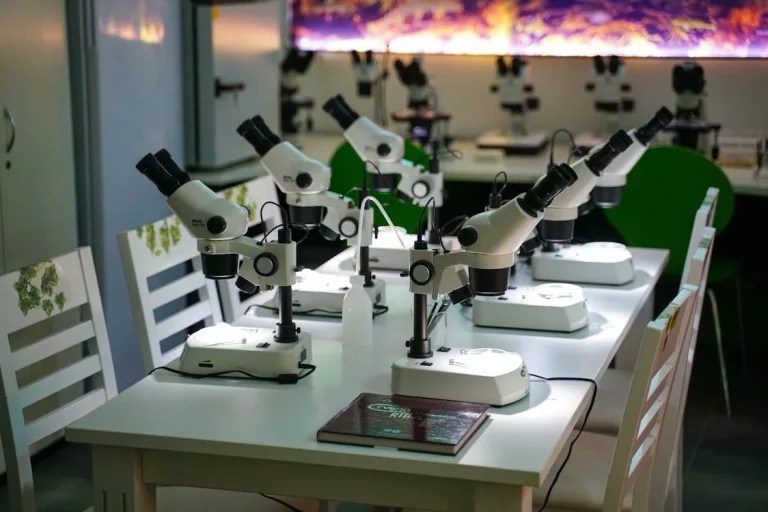The investigative nature of forensic sciences requires a tool that could help scientists unmask as many details as possible in the artifacts they are investigating. Countless cases have broken over time after investigators spotted minute features in evidence that tie back to the perpetrator. This is a need that SEM products can effectively fulfill.
SEM stands for scanning electron microscopy. This technology uses a stream of electrons to produce illumination and create an image of microscopic objects. SEM is superior to optical microscopy because of its higher magnification and resolution. With these microscopes in their arsenal, forensic scientists can bring out details as small as a nanometer that could unlock information and close the investigation.
How Electron Microscopes Work
There are two forms of electron microscopy – transmission and scanning EM.
Both use electron transmission to create an image of the specimen. However, they differ in the manner in which they make use of the transmitted electrons. In transmission electron microscopy, an objective lens beneath or behind the specimen collects the transmitted electrons. The imaging system then creates an image based on the pattern the objective lens receives.
On the other hand, scanning electron microscopy analyzes the pattern of secondary electrons to build the picture. These secondary electrons result from the impact of primary electrons on the specimen. This impact dislodges free electrons, which are “scanned” by an objective lens above the specimen.
TEM is generally superior to SEM in magnification. However, scanning electron microscopes have a wider field of view. This means that SEMs can produce images covering a wider area of the specimen than TEMs can.
Areas in Forensic Science That SEMs Can Help
Their capabilities make scanning electron microscopes ideal for numerous forensic studies. In criminology, for example, SEMs are a big help in the following fields:
· Gunshot residue analysis
Spent bullet casings are primary forms of evidence in crimes that involved gunshots. However, some perpetrators cover their tracks by removing any bullet casings. Before SEM, the absence of used shells makes it difficult to confirm the use of a firearm. However, SEMs now allow investigators to analyze residues in the victim’s body and look for specific particles that can tie the crime to a gun.
· Bullet comparison
Each weapon leaves unique characteristics on every bullet that it fires. These markings come from the barrel’s shape and the firing pin. Discerning these details help investigators identify the exact firearm used for the crime. SEMs expose several other details in high resolution, giving forensic detective valuable information like where they were manufactured.
· Crime scene particle analysis
Aside from gunshot residues and bullets, crime scenes often have other pieces of evidence. House break-ins, for instance, almost always involve shattered windows. SEM can help investigators match any glass fragments on a suspect with fragments collected from the crime scene. This analysis requires high-resolution images to bring out the details necessary for matching.
· Fingerprint analysis
The traditional method of collecting and analyzing fingerprints was to “dust” areas with special powders. Fingerprints on metal surfaces, however, will not require this approach. The conductivity of these surfaces makes them ideal specimens for scanning electron microscopy. SEM can yield clearer images that raise the possibility of matching with existing prints on the database.
Crime scene investigations are not the only areas in which SEMs can prove effective and useful. They can also be useful in forensic anthropology, pathology, and epidemiology.
Forensic epidemiology studies disease outbreaks like the current pandemic. In this case, electron microscopes helped in discovering the original strain of the COVID-19 as well as its succeeding variants. Image comparison unmasked the genetic deviations that distinguished the numerous variants from the first virus that spread out from Wuhan, China.
Aside from studying epidemics, forensic epidemiology can also help determine foul play in deaths resulting from otherwise treatable illnesses.
On the other hand, forensic anthropology investigates the details of victims that had died long before their bodies were discovered. These victims are usually in the advanced stages of decomposition. SEMs help in this field by providing high-resolution images of bones, teeth, and surviving body tissue that may hold clues to the cause of death.
Last but not least, scanning electron microscopes allow forensic pathologists to take a close look at the injuries suffered by the victim to determine the exact cause of death. They help investigators identify fatal wounds as well as bacterial or viral infections that may have killed the victim. While forensic anthropology looks at clues pointing to the answer, forensic pathology aims to study those clues and draw a conclusion.
The Bottom Line
The amazing capabilities of scanning electron microscopes and their counterparts, the transmission electron microscopes, bring out details that are too small for an optical microscope to capture.
This unparalleled resolution opens up worlds where these microscopes can be useful. Forensic sciences work to reveal details that are usually hidden from the naked eye. SEM imagery brings out vivid details from pieces of evidence like bullet casings, fabric, fingerprints, etc. With the help of this technology, investigators can break cases open faster than they could without electron microscopes in the lab.
Read More: A Guide to Finding the Best Arthroscopic surgeon around you: A Guide for a common man!

